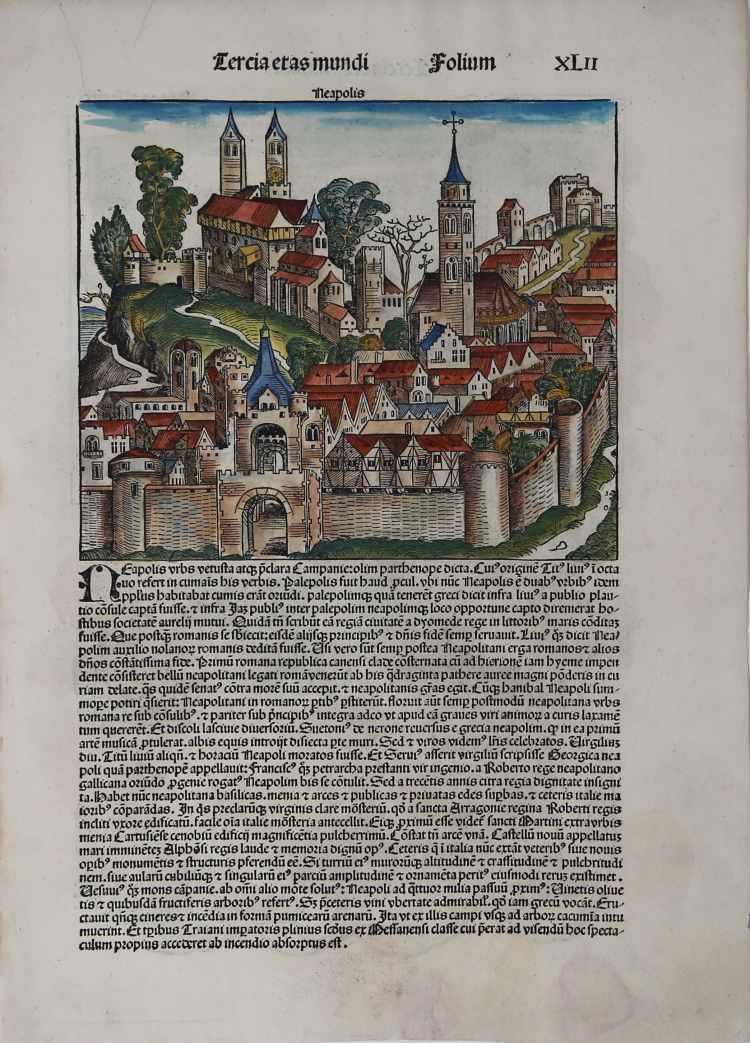



| Reference: | s34992 |
| Author | Hartmann SCHEDEL |
| Year: | 1493 ca. |
| Zone: | Naples |
| Printed: | Nurnberg |
| Measures: | 224 x 192 mm |


| Reference: | s34992 |
| Author | Hartmann SCHEDEL |
| Year: | 1493 ca. |
| Zone: | Naples |
| Printed: | Nurnberg |
| Measures: | 224 x 192 mm |
A imaginary view of Naples by Hartmann Schedel, Folio XLII (42) from: Liber Chronicarum. (= Nuremberg Chronicle). Nuremberg, Koberger, 1493.
Woodcut, finely hand coloured, in very good condition.
This major work, by the Nuremberg doctor Hartmann Schedel, generally known as the Nuremberg Chronicle was printed by Anton Koberger, the foremost printer of the day. It is a history of the world from the Creation to contemporary times. The work is remarkable for its illustrations, design and its woodcuts and description of cities. The views are some of the earliest representations of towns and cities, with around 116 places being identified by name. The numerous woodcut views, illustrations and maps are made by Michael Wohlgemuth and Wilhem Pleydenwurff and their workshop including Albrecht Dürer.
Hartmann SCHEDEL (Norimberga 1440 - ivi 1514)
|
The medical doctor and humanist Hartmann Schedel, grew up in Nuremberg and first studied liberal art in Leipzig. In 1463 he went to Padua together with the humanist Petrus Luder, to study medicine, Italian, Greek and Hebrew. In 1466 he returned to Nuremberg as a medical doctor and settled as the Nuremberg town doctor. He was a prominent member of the Nuremberg circle of humanists around Pirckheimer, Hieronymus Münster and Konrad Celtis. His comprehensive private library was among the most important of his time, not only because of the books themselves, but also because of its numerous prints, miniatures and graphic sheets, which Schedel used to add to his books. Hartmann Schedel became famous for a world chronicle entitled 'Schedelsche Weltchronik' in his honor.
It is a world history containing humanist historical articles, and was published in Latin and German by Anton Koberger in Nuremberg in 1493. It was known as the largest undertaking in the book-making industry of that time and with its over 1800 woodcuts is one of the most richly illustrated incunables ever made. The high-quality artistic woodcuts were made by the German painter and woodcutter Wilhelm Pleydenwurff and his father-in-law Michael Wolgemuth in whose Nuremberg workshop Albrecht Dürer was an apprentice until late 1489.
|
Hartmann SCHEDEL (Norimberga 1440 - ivi 1514)
|
The medical doctor and humanist Hartmann Schedel, grew up in Nuremberg and first studied liberal art in Leipzig. In 1463 he went to Padua together with the humanist Petrus Luder, to study medicine, Italian, Greek and Hebrew. In 1466 he returned to Nuremberg as a medical doctor and settled as the Nuremberg town doctor. He was a prominent member of the Nuremberg circle of humanists around Pirckheimer, Hieronymus Münster and Konrad Celtis. His comprehensive private library was among the most important of his time, not only because of the books themselves, but also because of its numerous prints, miniatures and graphic sheets, which Schedel used to add to his books. Hartmann Schedel became famous for a world chronicle entitled 'Schedelsche Weltchronik' in his honor.
It is a world history containing humanist historical articles, and was published in Latin and German by Anton Koberger in Nuremberg in 1493. It was known as the largest undertaking in the book-making industry of that time and with its over 1800 woodcuts is one of the most richly illustrated incunables ever made. The high-quality artistic woodcuts were made by the German painter and woodcutter Wilhelm Pleydenwurff and his father-in-law Michael Wolgemuth in whose Nuremberg workshop Albrecht Dürer was an apprentice until late 1489.
|